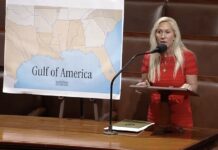
Excerpts from the final report of a special grand jury investigating efforts by former President Donald Trump and his Republican allies to overturn Georgia’s 2020 election were released Thursday, including concerns that some witnesses lied under oath.
The nine-page filing adds little new information about the investigation but does note the special grand jury did vote unanimously that “no widespread fraud took place in the Georgia 2020 presidential election that could result in overturning that election.”
The limited release comes after Fulton County Superior Court Judge Robert McBurney ruled Monday that the most substantial sections of the report should be kept private — for now — to protect due process rights of those who might face criminal charges in the future.
But the introduction, conclusion, and a section outlining concerns about witnesses lying under oath to the special grand jury are now public because they do not name names, McBurney said and comes as the years-long probe into election interference enters a new phase.
It has been more than two years since sustained efforts to reverse Trump’s election defeat failed, 13 months since Fulton County District Attorney Fani Willis requested a special grand jury to investigate those efforts, nine months since the jury began its work, and weeks since its dissolution.
Now, Willis and her office will have to decide what charges to pursue against an array of players in the multi-pronged attempt to subvert the state’s presidential results, ranging from the state Republican party chairman and those who falsely claimed to be presidential electors to lawyers in Trump’s inner circle to, potentially, the former president himself. Since the special purpose grand jury does not have the authority to issue indictments, Willis must instead use a regular grand jury to make her case in the future.
Thursday’s document release does not shed much light on the grand jury’s recommendations nor their work’s potential influence on the DA’s decisions and will likely kick off much speculation about the next steps for prosecutors and who could face indictments.
What does the limited release say?
Not much, which is not surprising.
The filing released Thursday has very limited new information, which the judge alluded to in Monday’s order. Four of the nine pages are the order allowing three sections to be published and cover sheets for the different exhibits.
The introduction of the report spells out the scope and scale of the special purpose grand jury, from Willis’ initial request to convene the jury to the 75 witnesses the group heard from. Additionally, the findings that have not been published include recommendations on indictments, relevant sections of state law, and the vote of the grand jury on each section or topic in their report.
The introduction also notes that after hearing from an array of experts, election workers, state officials, and those who claimed fraud took place, they found no evidence of widespread fraud that could have altered Trump’s defeat.
The final section of the report briefly says the jury believes one or more witnesses lied under oath and recommends the DA’s office seek indictments “where the evidence is compelling.”
It concludes with gratitude towards the DA’s office staff that assisted the jury in the roughly eight-month investigation, noting that the office played no role in recommendations and was free to seek prosecution above and beyond what the investigation recommended.
The report was completed on Dec. 15, 2022, and appears to also run just nine pages, without counting likely exhibits, appendixes or other evidence they used to support the recommendation.
A final page included in the filing is an addendum noting the grand jury voted to recommend publishing its report without recommending when or how and that at no time were there more than 24 jurors present when receiving evidence.
What the report excerpt doesn’t say
A lot, though that won’t stop people from trying to read between the lines.
The judge wrote in his Monday order that the report was quite effective in its stated purpose in investigating efforts to meddle with the presidential results.
“Having reviewed the final report, the undersigned concludes that the special purpose grand jury did not exceed the scope of its prescribed mission,” the order read. “Indeed, it provided the District Attorney with exactly what she requested: a roster of who should (or should not) be indicted, and for what, in relation to the conduct (and aftermath) of the 2020 general election in Georgia.”
We do not know: what sections one through seven of the report say, who the grand jury recommends should face indictments from the DA’s office, or what crimes they allegedly committed.
Thursday’s release brings new information that the jury believes witnesses lied under oath during their testimony, but left unsaid is who they believe lied, what they allegedly lied about, and if there is any evidence to back up the jury’s belief.
We also do not know if the special purpose grand jury found any high-profile incidents were problematic but did not break any laws or if people who were told they were potential targets should not actually face charges. Nor is it known whether jurors’ views on any issues saw consensus or were contentious.
In the course of the closed-door investigation, court filings seeking to compel out-of-state witnesses to appear and statements made by those involved appear to suggest interest in hearings where various Trump allies spread falsehoods about the state’s election results to convince lawmakers to reverse the outcome, as well as the scheme to appoint alternate Republican presidential electors.
More than a dozen people were told they could face prosecution for their actions, including Trump’s onetime personal attorney Rudy Giuliani and the 16 fake electors led by Georgia GOP Chairman David Shafer. It is not clear if any of them are named in the report and what the grand jury recommends be done with them.
Much attention has also been placed on Trump and potential indictments for his efforts, including an infamous call to Georgia’s Secretary of State asking him to “find” votes, calls to other officials about the 2020 election, false claims of fraud he made about the state and its election system and other comments made in the leadup to the Jan. 6 insurrection attempt by his supporters.
It is not clear if Willis will take the unprecedented step of seeking charges against the former president, nor is it clear if she is opting not to indict him. What we do know is that Trump was never called as a witness or asked to come in front of the grand jury to testify — but that does not necessarily mean he will or will not be prosecuted.
What’s next
The special grand jury is a rarely used legal tool that does not have the power to issue indictments, so Willis will have to utilize a regular grand jury if she wants to seek charges.
Willis has given no timeline on her decision, despite telling the judge decisions were “imminent” at a hearing last month. Grand juries in Fulton County meet regularly and indictments could come at any time, but any resolution of prosecution related to the 2020 election is unlikely to come swiftly.
The rest of the report and any associated evidence likely will not be released until Willis acts on the recommendations and decides how to proceed.
________
This article appears on Now Habersham through a news partnership with GPB News







